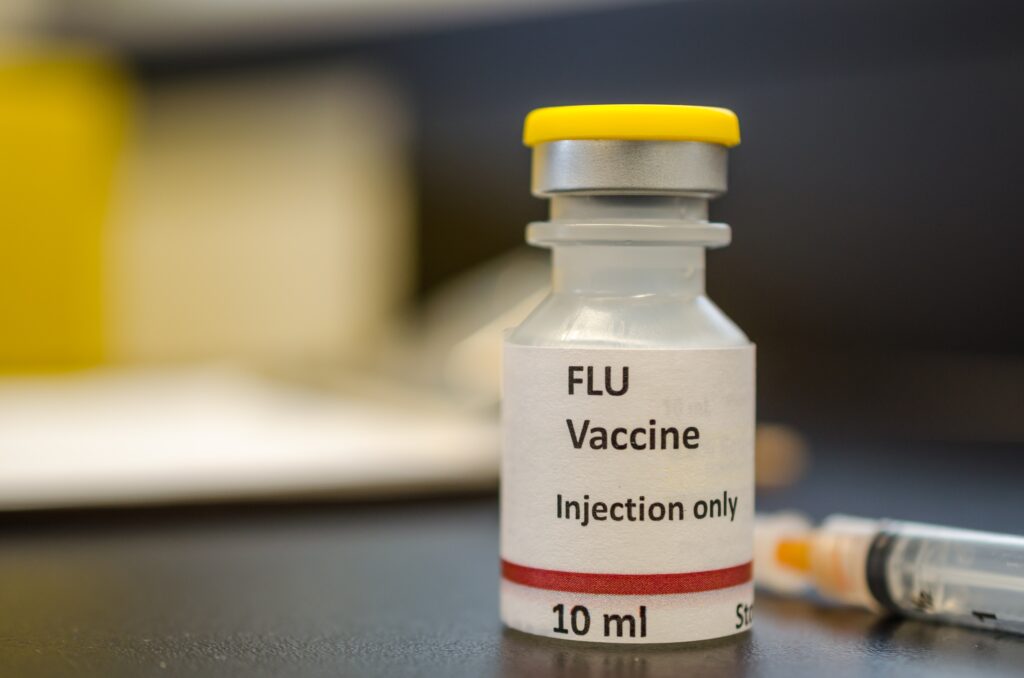
A greater proportion of healthcare workers have been forgoing influenza vaccination since 2020-2021. Here we explore how they can benefit from the flu shot, analyze data about their vaccination rates through the years, address the barriers to getting vaccinated, and discuss recommended strategies to improve vaccination rates.
Why healthcare workers need flu vaccination
Healthcare workers are on the front lines facing exposure to pathogens such as the flu virus from sick and infectious patients. In 2022, 360,000 patients in the U.S. were hospitalized due to flu-related complications. The flu vaccine is an easy way to protect healthcare workers from a preventable disease that can take a toll on their health.
The vaccine also reduces the spread of the disease. Flu is infectious a day before the onset of symptoms. If a healthcare provider catches the flu, they will be shedding the virus a day before they know they are sick. This could put vulnerable hospitalized patients at risk of infection and increased morbidity.
Studies have shown that when healthcare workers got vaccinated, there were fewer influenza outbreaks in healthcare settings. The increased number of immunizations correlated with fewer diagnosed cases of flu in this group and fewer cases of hospital-acquired flu in the patients.
For these reasons, the CDC and the Advisory Committee on Immunization Practices recommend that healthcare workers receive their annual influenza vaccine.
Reduced flu vaccination rates among healthcare workers
Influenza (flu) vaccination rates have been declining among healthcare providers (HCP) over the past few years. Since 2013 when the Centers for Medicare & Medicaid Services started requiring acute care hospitals to report data on facility-level vaccinations, we saw an increase in the flu vaccination rate among HCP every year until 2020. The vaccination rates were the highest in the year 2019-2020 when 90.7% of HCP got the flu vaccination.
The arrival of COVID-19 later that season seemed to change that trend. Instead of increased awareness of infectious respiratory diseases and greater flu vaccine adoption rates in the wake of COVID-19, the rates fell to 85.9% in 2020-21, 80.4% in 2021-2022, and 81.1% in 2022-2023.
The rate of 81.1% in 2022-2023 included data from approximately 8.4 million HCP from 4,057 acute care hospitals. The data combines vaccination rates from different categories of HCP. The rates of flu vaccination were higher among hospital employees (83.1%) and also among nonemployees such as students and volunteers who worked at the hospitals (85.2%). It was the lowest among nonemployee licensed practitioners, who as a group had only a 67.2% flu vaccination rate.
The same year, the rate of flu vaccinations for HCP working in long-term care facilities was 47.1%. This aggregate included data from approximately 2 million HCP from 13,794 nursing homes. In this group, the coverage was lower among employees (46.1%), but higher among nonemployee licensed practitioners (55.3%) and students and volunteers (57.7%).
The trends of vaccination were different in different types of healthcare institutions and different parts of the country.
The rates of vaccination among HCP working in acute care hospitals were the lowest in the Pacific region and the highest in the Midwest. The rates of vaccination among HCP working in nursing homes were the lowest in the South and highest in the Pacific region.
Data broken down into groups
During the 2020-2021 flu season, the following coverage was reported among different HCP groups.
Physicians (91.3%)
Nurses (90.3%)
Pharmacists (90.3%)
Assistants/aides (69.0%)
When employer required flu vaccination (95.9%)
Overall coverage when the employer recommended flu vaccination (76.2%)
Overall coverage when the employer did not recommend or require vaccination (46.0%)

Common reasons for vaccination uptake or rejection
The CDC reports that in the 2020-2021 flu season, the main reasons that influenced the decision to get the flu vaccine were as follows:
Reasons why HCP got vaccinated
- “To protect myself from the flu” (36.0%)
- “Because it was mandatory, or I had to for work” (22.3%)
- “To reduce flu’s impact on the health care system during the COVID-19 pandemic” 10.5%)
Reasons why HCP did not get vaccinated
- “I do not need the vaccination” (17.3%)
- “I might experience side effects or get sick from the vaccine” (12.2%)
- “I don’t think the vaccination is effective in preventing flu” (11.8%)
Other reported barriers to getting vaccinated include:
- Feeling that there is not enough time to get vaccinated or it would be inconvenient to do so.
- Perceived low likelihood of catching the flu
- Confidence in homeopathic medications
- Avoidance of medications
- Avoidance of needles
Strategies to promote flu vaccination uptake by healthcare workers
The Healthcare Infection Control Practices Advisory Committee (HICPAC) and the Advisory Committee on Immunization Practices (ACIP) provide the following strategies for healthcare institutions to encourage greater flu vaccination rates among HCP:
- Education and campaigns. Some of the reasons for vaccine refusal include underestimation of the dangers of the flu and misconceptions about the vaccine’s efficacy and safety. Educational campaigns providing accurate information about the flu vaccine and emphasizing the benefits of the vaccination to both the staff and their patients can be effective at increasing rates of vaccination.
- Role models. When senior medical staff, infectious disease specialists, and opinion leaders get the flu vaccine, it can have a positive effect in increasing the vaccination rates of others in the facility.
3. Improved access. Vaccination rates can be improved by removing the barriers of cost and inconvenience. Vaccine clinics in easy-to-access locations offering vaccines during flexible hours can improve vaccination coverage. Vaccination drives at conferences, in other areas where HCP congregate, and mobile carts offering vaccines can all help increase vaccination rates.
The information provided in our blog posts is for informational purposes only and is not intended as a substitute for professional medical advice, diagnosis, or treatment. Always seek the advice of your physician or other qualified health provider with any questions you may have regarding a medical condition. Never disregard professional medical advice or delay in seeking it because of something you have read on this blog.






